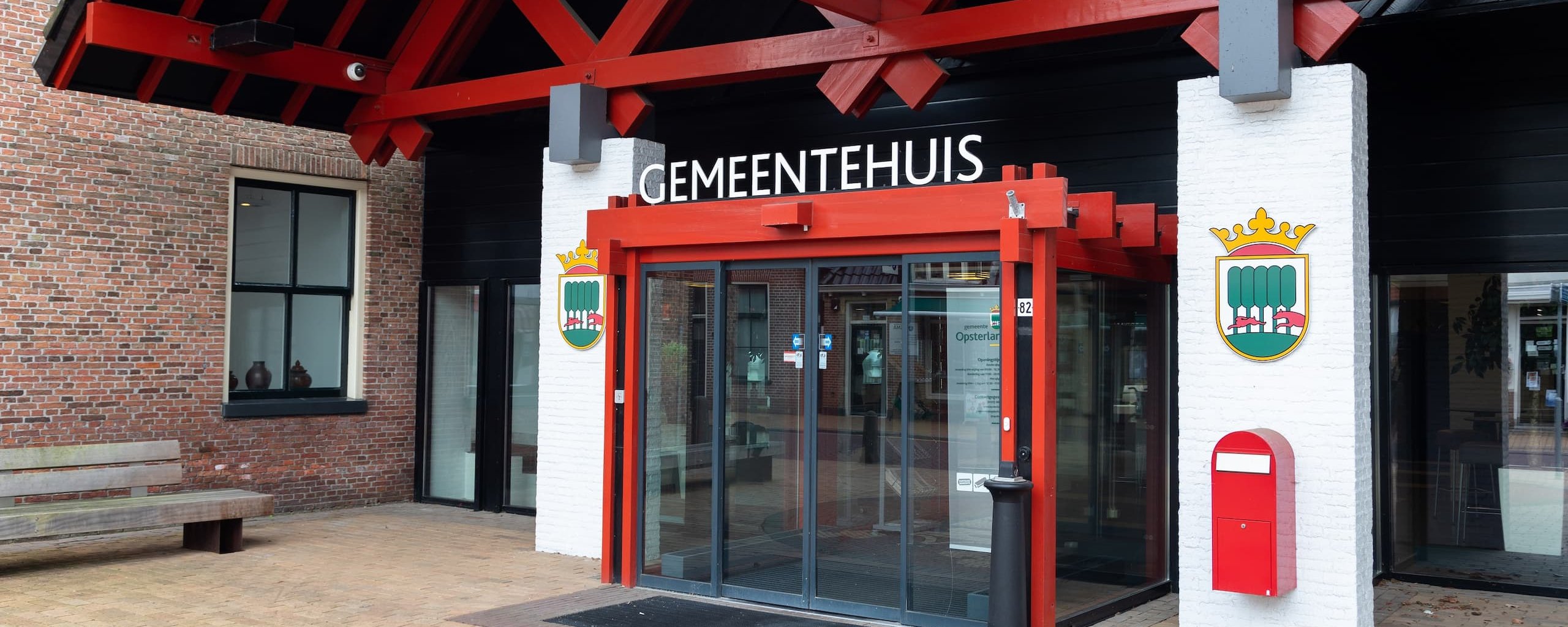2. Issues
All tasks at a glance
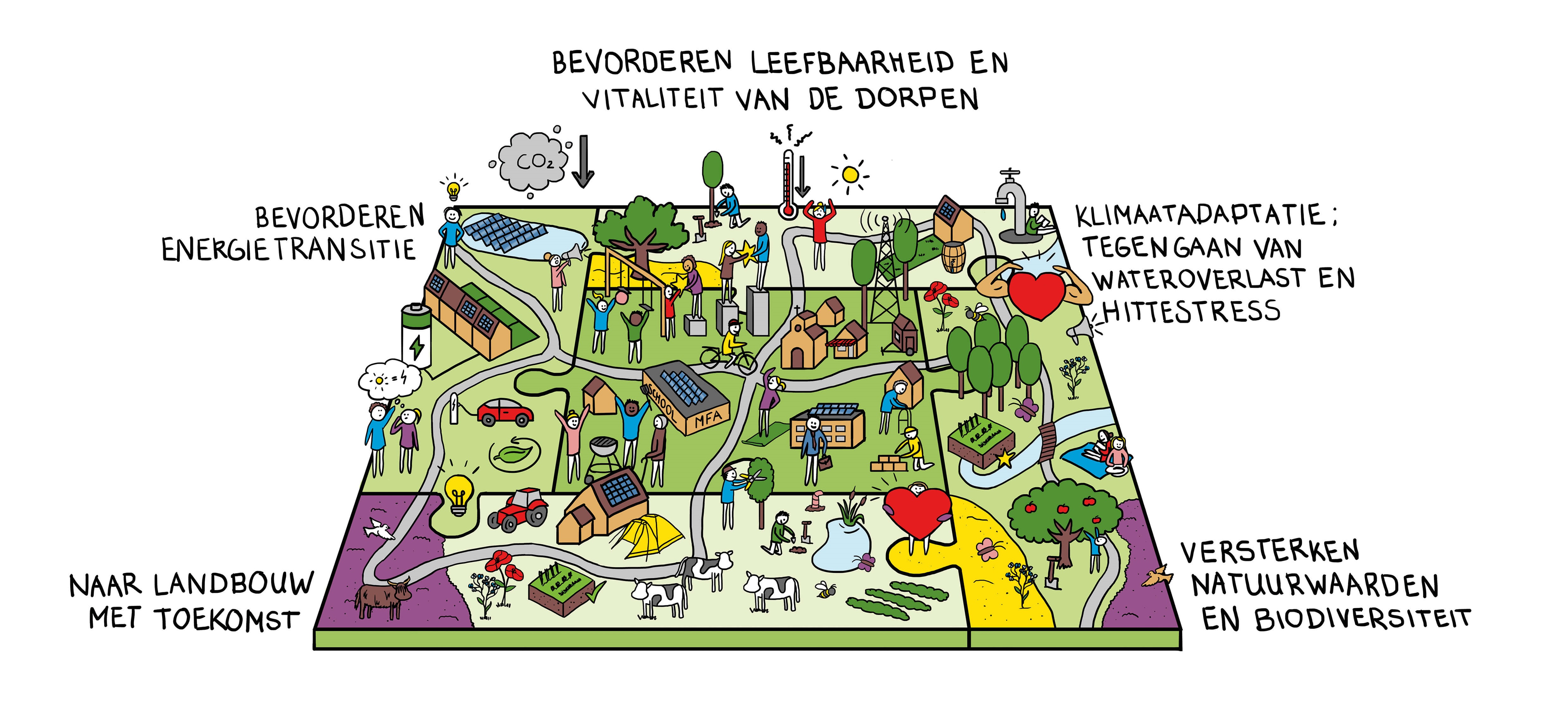
Issue 1 - Livable and vital villages.

A. What is the task?
It is good to live, recreate and work in Opsterland. The municipality is a rural municipality with many qualities, located between roughly Drachten and Heerenveen in beautiful Southeast Friesland These qualities are certainly also expressed in the 16 villages. The region of Southeast Friesland does not (yet) have a decline in population and is relatively strong in terms of livability, economy and housing. Although population projections indicate that population decline will be an issue in Southeast Friesland, and thus also in Opsterland, in one or two decades, it is not yet a current issue.
Demographic projections show that the population structure will change in the coming years. Between now and 2035, the municipality's population is expected to decline. However, the number of households will still increase during this period.
Therefore, it is important to regularly reflect on the quality of social structures and facilities in the villages.
Aging and de-greening is a hot topic for the coming years. National policy is to have the elderly live at home longer and longer. They will therefore have greater reliance on additional mural facilities, family and village associates. An unintended effect of this is that the flow in the housing market is not promoted, even stagnates. Therefore, we should instead focus more on facilities that a village itself would like to maintain. In combination with the current tightness and price levels in the housing market, it makes it difficult for starters and young people to obtain suitable housing.
B. What does this mean for Opsterland?
Opsterland is primarily a municipality where it is good and safe to live in a beautiful and varied landscape. It is important that the villages remain livable, vital and attractive. This can be achieved through a good and future-oriented supply of housing, a flourishing club life, space to do business and sufficient accessible and affordable general and community facilities.
Besides living, five other basic functions are important: education, sports/leisure, meeting, Health and business/work. The municipality works together with residents, associations and entrepreneurs on solutions and improvements to keep villages vital and livable. A vital village offers various starting points for residents to stay physically, mentally and socially-emotionally healthy. The vital village has priority and is the starting point in the Prevention Agenda adopted in 2021.
A and B summarized
- It is good to live, recreate and work in Opsterland. The municipality is a rural municipality with many qualities. These are expressed in the 16 villages. We see the tightness in the housing market and the vulnerability of social cohesion in the villages. The attractiveness to (continue to) live in Opsterland requires continuous attention.
- We have a future-oriented housing climate. The housing stock matches current and future demand and the changing population composition. We want to continue to provide space for additional housing and strive for a good quality housing stock. We invest in attractive villages with strong social cohesion. There is sufficient housing (quantity and quality), tailored to the needs of different target groups.
C. What choices do we make?
1. Housing focused on the future
- We strive to improve the quality of the existing housing stock: future-proof, energy-efficient and more lifecycle-proof.
- We match the housing needs in the villages and take into account the nature and scale of the village.
- We strive to add housing to the housing stock. To this end, we deploy new construction. The condition is that these homes must have quality in terms of sustainability and life-cycle resistance. We also strive for homes that are rare in the stock and homes that will continue to be needed in the future.
- We prioritize infill within current village contours.
- We strive for sufficient -; affordable - and available social rental housing for low and middle income earners.
- We strive to use temporary housing, because of flexibility.
2. Keeping basic services accessible
- We want to keep basic services (accessible) in every village.
- We work with resident initiatives to maintain other socio-cultural and support facilities as well.
- Digital accessibility is taken for granted in modern society.
3. Facilitating the inclusive society
- We are committed to "Krêft fan de mienskip.
- We want to invest in villages. In doing so, we focus on strong social cohesion.
- We believe it is important that everyone counts and participates.
- We support residents to live independently as long as possible.
- It is important for every resident to be able to develop to their full potential.
4. Space to do business
As a municipality, we ensure sufficient development space for businesses.
- The goal is to match the supply of locations for businesses with demand. In principle, the goal is to let companies with a need for space find a place within the municipality. Whether this succeeds depends in part on the nature and size of the business. If there is high demand and little supply, we look at whether expansion of business sites is necessary. We also look at supply and demand in the region.
- Opsterland's business parks are intrinsically of high quality. In addition, they can also serve as a "getaway area" for smaller-scale companies than the larger industrial business establishments, for example those in Heerenveen and Drachten.
Activity in the villages
- Villages can remain vital and livable when local businesses are maintained and allowed to flourish. Small and medium-sized businesses, retail trade, the hospitality industry and certainly agricultural enterprises are of enormous importance. Whereby the latter also play a role in the livability of the outlying area. Small-scale activity and appropriate growth will always be welcomed. In that context, we welcome the realization of small or medium-sized business incubators. In addition, we promote circular enterprise and local spending.
We strive for vibrant compact core shopping areas.
- We are committed to well-functioning, attractive and future-proof shopping areas in a changing retail landscape. Here we distinguish two main themes.
- Reduce vacancy and excess capacity and unnecessary planning capacity in retail floor space.
- Strengthen the appearance, experience and attractiveness of shopping areas.
There is room for recreational enterprises
- Recreation and Tourism is a sector with potential in Southeast Friesland. The landscape is unique, varied and inviting. Entrepreneurship is well developed, but here and there it can still make a quantitative and qualitative leap. Viewed through a tourism lens, Southeast Friesland is also known as "The Other Friesland". To make this brand grow even better, we will facilitate organizationally and spatially.
D. Existing policy frameworks.
- Prevention Agenda Opsterland 2021-2030.
- The coalition agreement Mei-inoar foarút 2022-2026
- Vital Opsterland, Vision of Basic Facilities and Accommodations 2010-2030 led to Vital Opsterland version 2 (2013)
- Basic analysis Dorpsspiegels Opsterland 2017 - 2018
- Housing Vision 2017-2021 (Update Housing Vision 2022-2026)
- Sports and exercise framework memorandum 2017-2021
- Integrated Education Housing Plan 2015-2030
- Village Hall Policy Framework Memorandum (Nov. 15, 2021 by council resolution)
- Seizing opportunities Recreation and tourism in Opsterland (2016-2020)
- Development agendas Sustainable, Livable and Inclusive Opsterland
- Regional Agreements on Housing Southeast Fryslân, 2016-2026 (2018).
- Performance agreements housing corporations and the tenants' organization The Residents' Council (Annual).
- Retail Vision 2015
- Business parks southeastern Friesland
- Lighting policy plan 2009-2014
E. Current projects and policies.
- We draw up new village visions together with the villages. To this end, updated village mirrors will be created in 2022. They give a picture of the state of affairs in the various villages.
- Establish village hall policy frameworks.
- Course plans for all village houses.
- Village coordinator appointed (2020).
- Update Housing Vision (2017-2021).
- Expanding and flexibilizing the housing space (New housing agreements with the province for the period 2020-2030)
- Regiodeal Zuidoost Friesland 2020 - 2023 with Vital Villages as one of its pillars. An important part of this is the Gorredijk program aimed at strengthening the regional position of Gorredijk. Regional tourism development strategy Southeast Friesland Regional cooperation RenT in the framework of 'The other Friesland'.
- The first action line of the prevention agenda focuses on strengthening social networks in villages.
- Retail vision renewal
- A housing analysis to see what is needed in terms of housing and Health.
This task contributes to the following Sustainable Development Goals (SDGs)
Task 2 - Climate adaptation, flooding and heat stress
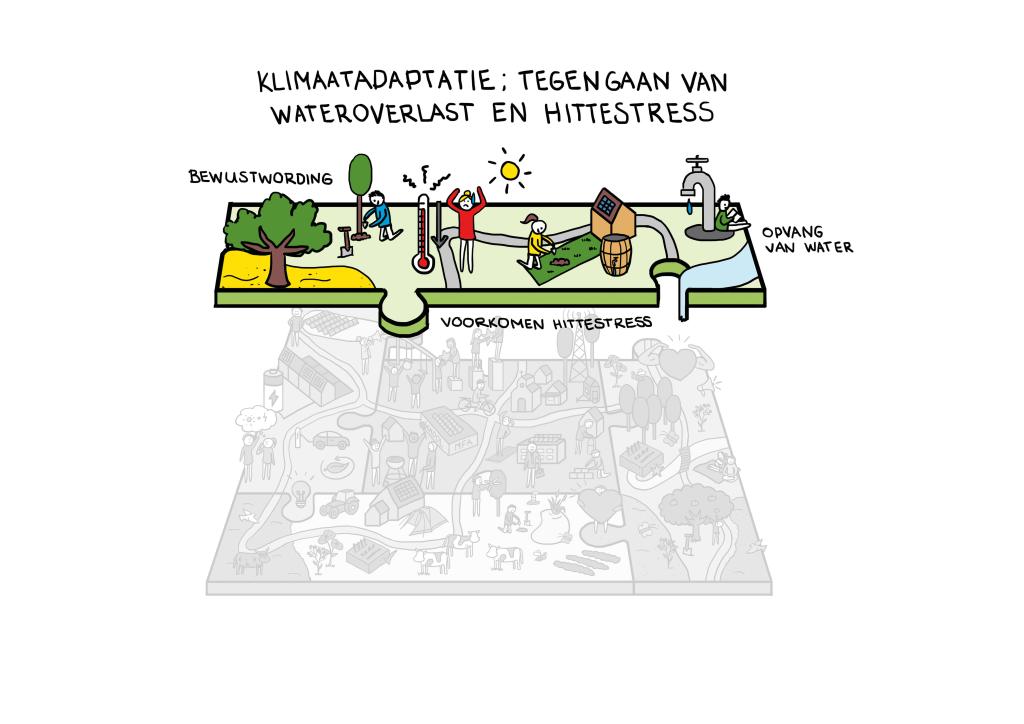
A. What is the task?
The climate is changing. The weather is becoming more extreme: we face more and heavier showers. As a result, the risk of flooding and flooding is increasing. Summers are becoming drier and hotter. We see the consequences of this, such as heat stress, all around us. In the Netherlands, but also worldwide, we are working hard to combat climate change. However, we must take into account that some of the changes cannot be reversed. A climate stress test was recently conducted for Opsterland. The site www.frieseklimaatatlas.nl contains the results.
B. What does this mean for Opsterland?
The effects of climate change are especially felt in villages. Building and paving make it difficult for water to get away and can accumulate, causing flooding. Temperatures rise higher between buildings and on paved areas than in the outlying areas; we call this heat stress. Especially in the design of villages it is important that we take measures to adapt to the changing climate. In Opsterland there are also differences between the sandy areas and the peat areas. The varied landscape and differences in soil conditions are described in Chapter 5. For example, it is drier faster in the sandy areas and we must be careful that the groundwater does not sink too far. Disconnecting rainwater runoff from the sewer system so that it can go toward surface water helps to retain water longer in the area and prevent drought in sandy soils. In peatlands, water collection and retention is easier. We have the desire in the peat area to raise the water level in several places to conserve the peat and prevent CO2 emissions. Together with Wetterskip Fryslân we are working on measures to find solutions for this. A robust water system helps us do this.
Heat stress can be countered by less paving and more greenery near homes and in public spaces, shade-providing vegetation in outdoor areas, green roofs on homes and businesses, as well as smart material choices.
A and B summarized
- The climate is changing. The negative effects are becoming more and more apparent.
- We want to adapt our environment to the consequences of climate change and counteract the adverse effects.
C. What choices do we make?
-
We want to prevent residents and businesses from experiencing flooding from heavy rainfall, heat stress from prolonged temperatures above 30 degrees, and no or less damage from prolonged drought; think crop yield loss or damage to nature.
As a municipality, we have the following measures in mind:
- a. Improve stormwater collection by installing separate sewers when replacing or constructing new sewers.
- b. In new building plans or restructuring of areas, the contribution to the climate challenge must be clear.
- c. Construction of small-scale water collection in areas where flooding may occur.
- d. Construct and/or add plantings or water features in areas where heat stress may occur.
- e. Make residents of the Opsterland municipality aware of their own role in climate adaptation. For example by encouraging more greenery in the garden, less paving by disconnecting rainwater runoff so that it can go towards soil and surface water.
- f. Climate adaptation measures can also help improve biodiversity.
D. Existing policy frameworks.
- Water task program (2020)
- Tree policy plan (2020)
- Provincial Environmental Vision POVI (2020)
- National Environmental Vision (NOVI) 2020
E. Current projects
By mid-2022, nearly 20% of the sewer system is a separated system. This means that another 80% must be converted from mixed sewers to separate sewers. Immediately ordering all sewers to be laid separately is not realistic in budgetary terms, it requires too large an investment logistically and financially. In principle, every time mixed sewers are replaced, separate sewers are installed. On the other hand, a mixed sewer is not replaced until it is technically due for replacement. By including the climate challenge in the consideration of whether or not to replace, we accelerate the replacement of mixed sewers to separate sewers.
- National Rural Land Program (NPLG).
- Fries Programma Landelijk Gebied (FPLG).
- Peatland Program
- Project Koningsdiep
- Natura 2000
- Risk dialogue
- Land managing organizations, such as It Fryske Gea; Natuurmonumenten and Staatsbosbeheer, agriculture and estates.
This task contributes to the following Sustainable Development Goals (SDGs)
Task 3 - Promote energy transition.
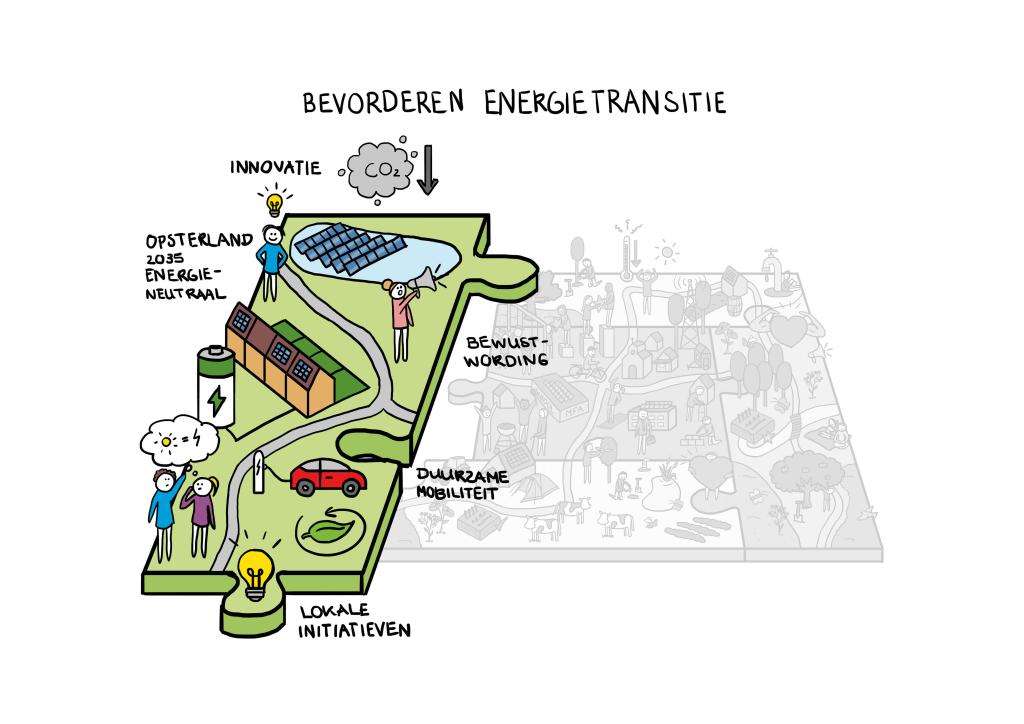
A. What is the task?
The Energy Transition as a major task has its origins in the Paris climate agreements (2015). The goals for the Netherlands are set out in the Climate Accord.
- In 2030, compared to the reference year 1990, we will save 49% in CO2 emissions. With the Rutte IV coalition agreement (2022), this has been increased to 55%
- By 2050, we reduce CO2 emissions by 98% compared to the baseline year. Fossil fuels, including natural gas, have been replaced in the built environment by sustainable sources and renewable energy.
B. What does this mean for Opsterland?
The agreements of the Climate Agreement have been elaborated in Opsterland in the Transition Vision Heat (2021) and the Regional Energy Strategy (2021) (RES). The Heat Transition Vision was drafted in cooperation with the municipalities of Ooststellingwerf and Weststellingwerf. The RES was prepared in cooperation with the province.
Opsterland takes responsibility and has the ambition to be an energy-neutral municipality by 2035. This means that in 2035, as much sustainable energy will be generated in Opsterland as consumed.
Energy transition has a major spatial and social impact. The generation of sustainable energy with for example sun and wind is visible in the landscape. Homes must be suitable for replacing natural gas. It is also important to focus on saving energy and changing behavior.
A and B summarized
- Based on the Paris Climate Agreement, the Opsterland municipality has assumed a responsibility in energy transition.
- We want to be energy neutral by 2035.
C. What choices do we make?
-
1. We partner with our residents to raise awareness and save energy
-
Energy that is not used does not need to be generated. For this reason, we are committed to saving a considerable amount of energy. Savings can be achieved mainly through the conscious use of energy, more efficient appliances and making homes more sustainable. This requires an active role of residents. Initiatives have already been taken in several villages. In consultation with them, we want to support, connect and strengthen them.
-
2. We facilitate and encourage local initiatives
Together with residents, we have an active role in making energy production more sustainable in and for our municipality. We support local initiatives. An important principle is that all forms of sustainable energy generation must have public support. Villages and residents must be able to participate and benefit from the revenues. We will draw the attention of grid managers to increasing grid capacity for local plans. -
3. We have an up-to-date Heat Transition Vision and are working with villages to develop implementation plans to save and disconnect natural gas
Natural gas must be replaced by a sustainable alternative by 2050. It is important that our residents know what alternatives to natural gas are available in the municipality and when natural gas will be replaced. The Heat Transition Vision elaborates on this. Anno 2022 in Opsterland there are almost no collective alternatives for the use of natural gas available. An individual solution per home or business, fully electric or hybrid, will then remain. -
This first vision focuses primarily on motivating, collaborating, facilitating and communicating. Local initiatives for disconnecting natural gas are worked out in implementation plans together with the villages. The developments in the field of sustainability are rapid. We therefore regularly update the vision.
-
4. We cooperate in the Regional Energy Strategy
We are working with all authorities and the grid operator in the province of Fryslân on the Regional Energy Strategy (RES). The main goal of the RES is the generation of renewable energy, with careful spatial integration, social support and attention to the necessary energy infrastructure. The focus of the RES is on sustainable energy supply for the built environment. The RES is updated regularly. -
5. We are committed to a sustainable energy supply.
At present, the preference is for generating solar energy. Preference is given to placing solar panels on roofs. Landscaping and participation are important for the construction of solar fields. We have laid down our policy for this in the Opsterland Solar Plan. Sun alone cannot meet our energy needs. Other options can also make an important contribution. In addition to solar, we offer room for new forms of sustainable/renewable energy if they are promising and can contribute to achieving our objective. In doing so, we take into account the impact of spatial interventions on our living environment. We look for solutions to fit in with the landscape, improve biodiversity and prevent negative effects on health.The municipality is actively involved in research into the possibilities for sustainable electricity generation and alternative heating and storage facilities in the longer term. We do this, for example, in a provincial context through the Regional Energy Strategy and the Living Lab Natural Gas-Free Districts and other knowledge networks.
In order to secure the energy supply even in times when there is no sun and little or no wind, or to spare the electricity grid during peaks in energy production, attention must be paid to storage and matching supply and demand. For this reason, we do not exclude (combination) projects of (large-scale) sustainable generation of energy. We are thinking of energy parks for solar, wind, green gas, hydrogen or a combination thereof. Besides an efficient and responsible use of the energy infrastructure, additional advantages are that here it is also possible to experiment with storing sustainable energy and creating generation in the immediate vicinity where it can be used.
-
6. We join projects that promote sustainable mobility
As an alternative to the use of fossil fuels for mobility, nationwide efforts are being made to electrify vehicle fleets. In this regard, we are joining a provincial charging station project.
D. Existing policy frameworks.
- Heat Transition Vision 2021
- Regional Energy Strategy 1.0 (RES) 2021
- Energy Transition Implementation Plan 2019
- Solar Plan Opsterland 2019
E. Current projects
- Natural gas-free neighborhoods pilot project
- Implementation of Heat Transition Vision
- Implementation of Regional Energy Strategy
- Provincial charging station project
This task contributes to the following Sustainable Development Goals (SDGs)
Task 4 - Towards agriculture with a future
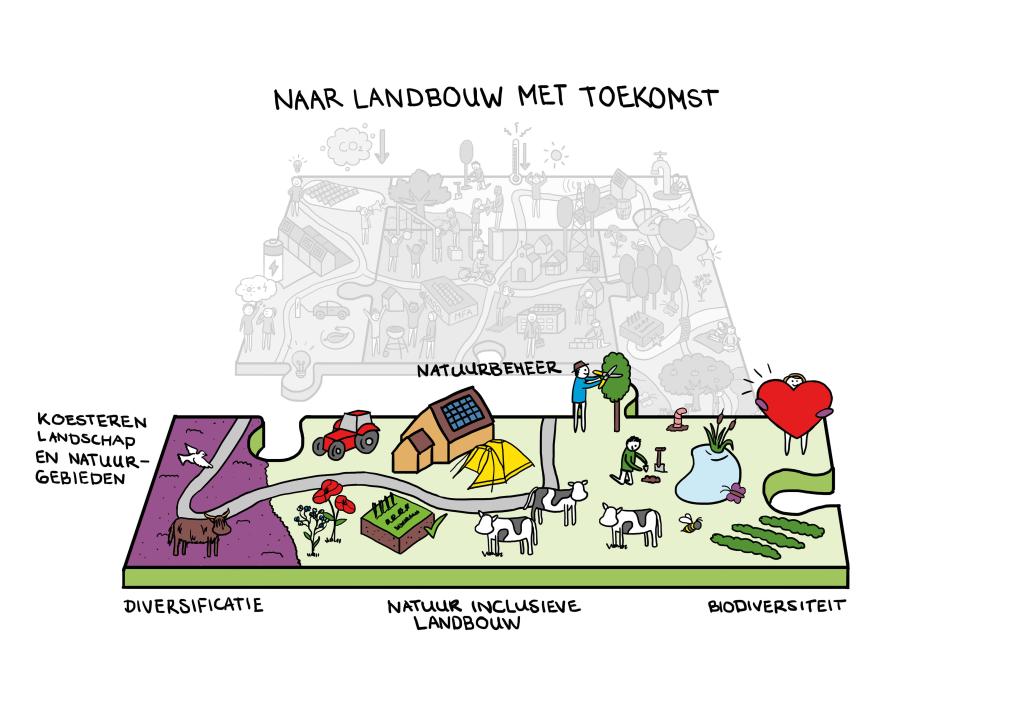
A. What is the task?
Opsterland has a predominantly rural and agricultural character. Chapter 5 describes the important part the agricultural sector has had and still has in the creation of the unique landscape and the preservation of natural values and biodiversity. The importance of the agricultural sector for the quality of life in villages and the outlying area was also mentioned. Land-based agricultural operations, especially livestock farming, are the most prominent. Because of the loss of biodiversity in the Netherlands and the fact that the Netherlands is committed to the Paris Climate Agreement, the agricultural sector is on the eve of important changes.
At the moment (2023), the discussion surrounding the nitrogen file is topical. Here nature restoration and the improvement of biodiversity are also receiving explicit attention. For example, by including measures to integrate nature in planning and operations. This applies not only to agriculture, but also to new construction and renovation of homes or businesses and to construction and maintenance work in (public) spaces. This is an additional contribution to improving biodiversity and restoring natural values.
Nature-inclusive agriculture is a sustainable form of agriculture that utilizes and protects biodiversity on and around the farm. It produces food within the boundaries of nature, environment and habitat. It is economically profitable and has social support. This involves improving biodiversity, soil and water quality, quality of life and the (cultural) landscape.
For a vital and future-proof development of the countryside, it is necessary to make the transition to a form of agriculture that is both ecologically and economically sustainable. After all, the sector needs a future perspective, with a view to a good earning model. This change must also contribute to biodiversity, landscape, animal welfare, healthy food and have broad social support.
The agricultural landscape and industry are healthy, viable, competitive and profitable in the long term. Agriculture that is land-based and circular contributes to this.
For parts of the agricultural sector, it will be a huge challenge to make that transition. We see that a number of companies have already made great strides in this regard. Nationwide, and therefore also in Opsterland, the necessary questions will have to be answered in the coming years, such as:
- How can (large) farms transform and remain profitable?
- How do we elaborate on the National Rural Area Program (NPLG), the Friesian Rural Area Program (FPLG) and the various sub-files within them, such as nitrogen, peat pasture, Water Framework Directive (WFD) and forest strategy.
The province encourages the agricultural sector to make the transition to sustainable, nature-inclusive and land-bound agriculture. Within the National Rural Area Program, policies for this are set out with corresponding budgets. In the provincial environmental vision, the province of Fryslân sets the basic principle that agriculture in Friesland will be circular, ecologically and economically sustainable by 2025.
B. What does this mean for Opsterland?
Due to economies of scale in recent decades, the number of agricultural businesses in Opsterland has decreased significantly and the area of agricultural land has decreased by over 11% in the last 10 years (see table below). In addition, a cautious increase can be seen in the number of farms with-and the area in natural grassland. This seems to be a cautious step towards sustainable and more natural agriculture.
|
Number of companies |
Area in hectares (rounded) | |||||
|
Year |
2000 |
2010 |
2021 |
2000 |
2010 |
2021 |
|
Farms total |
487 |
393 |
265 |
15.168 |
15.273 |
13.520 |
|
Livestock | ||||||
|
Grassland | ||||||
|
Permanent grassland |
469 |
376 |
254 |
13.402 |
11.156 |
9.584 |
|
Natural grassland |
9 |
34 |
50 |
93 |
683 |
760 |
|
Temporary grassland |
25 |
42 |
122 |
415 |
1.289 |
1.488 |
|
Green fodder |
151 |
168 |
140 |
1.131 |
1.866 |
1.587 |
|
Arable | ||||||
|
Arable vegetables |
0 |
1 |
1 |
0 |
12 |
0 |
|
Grains |
8 |
19 |
6 |
40 |
175 |
29 |
|
Horticultural open ground | ||||||
|
Flower bulbs and tubers |
2 |
1 |
1 |
26 |
11 |
6 |
|
Horticultural vegetables |
0 |
0 |
0 |
0 | ||
Source: CBS Statline
The decline in biodiversity, soil subsidence and CO2 emissions in the Peat Meadow area and the maintenance of the quality of the landscape require adapted business operations. The continuity of business operations is important for agricultural businesses. The entrepreneur naturally wants to maintain future prospects and business security.
Agricultural businesses make their own choices in business operations. This can be an increase in scale, but also a decrease in scale, organic, extensification, broadening and deepening. Natural conditions, such as water levels and soil quality, are becoming more decisive for business operations. Co-use of agricultural land for water storage and nature management will also become more influential. The agricultural sector will change as a result of European and national policies. It is expected that the sector will have sufficient adaptive capacity in this transition.
A and B summarized
- Agriculture is at the beginning of the transition that is both environmentally and economically sustainable.
- We support this transition to nature-inclusive agriculture.
- We endorse and support national and provincial policies and where our authority lies we help implement them.
C. What choices do we make?
1. We encourage nature-inclusive agriculture.
Together with the province we are committed to nature-inclusive agriculture in Opsterland, where this is possible. The main task lies with farms in or near Natura 2000 areas, in the Peat Meadow area and in groundwater protection areas.
- In doing so, we start from the principle of interweaving agriculture and nature and not separating them. By looking for similarities that do justice to both systems (agriculture and nature).
- Spatial scale of merging agriculture and nature should be determined in consultation with the actors; plot, farm, area, region or larger.
2. We consider it important that:
- the core of agriculture is that it is practiced as working on and in a living ecosystem;
- agriculture becomes land-based, circular and energy-neutral;
- agriculture contributes to biodiversity, landscape, animal welfare and healthy food;
- agriculture does not burden the environment;
- agriculture has social support;
- agriculture is sustainably economically viable.
3. We participate in the Friesian Peat Meadow Program (2021-2030).
4. Where possible, customization is made to facilitate the transition to nature-inclusive agriculture.
5. We join the National Rural Area Program.
D. Existing policy frameworks.
- Zoning Plan Outlying Area Municipality of Opsterland (2014).
- Grutsk op 'e Romte, Structural Vision Landscape and Cultural History (2013).
- Provincial Environmental Vision POVI (2020)
E. Current projects
Peat Meadows Program 2021-2030; Foarút mei de Fryske Feangreiden.
This task contributes to the following Sustainable
Goals (SDGs).
Task 5 - Strengthen natural values and improve biodiversity
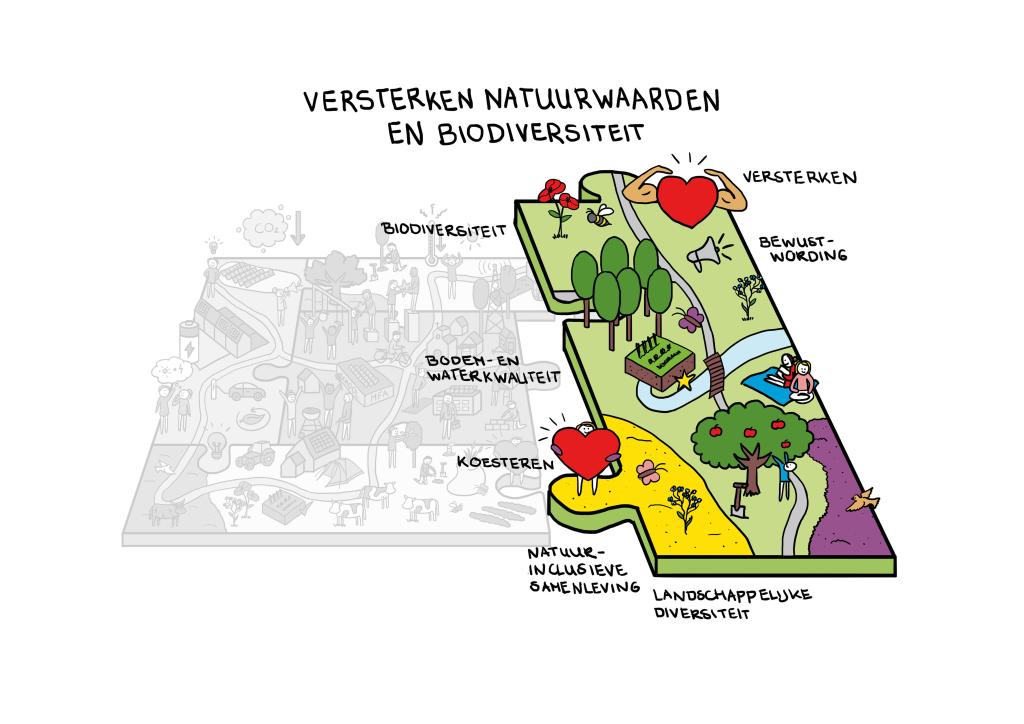
A. What is the task?
The quality of Dutch nature and thus biodiversity has been declining for years. This also applies to Opsterland. This process is cautiously reversing, but there is no solid recovery yet. Plant and animal species are disappearing and ecosystems are being disrupted by human activity (consumption, pollution, climate change, depletion of natural resources and natural areas). This can lead to problems for food production, drinking water supply, soil fertility, water storage, cooling. Nature restoration and biodiversity enhancement are of great importance.
B. What does this mean for Opsterland?
We cherish the varied landscape and natural areas in Opsterland. However, the decline in biodiversity is about more than just the loss of natural values. It is an indication of the quality of our overall living environment, and it can also have a detrimental effect on our health and perception of it. Such as security of sufficient food and energy, vulnerability to natural disasters, and access to clean water and resources. A biodiversity in balance provides many ecosystem services.
Biodiversity or biological diversity is the term used to describe the variety of life in a given area. " Bio" means life, "diversity" means alternation or variety. Biodiversity is about species of animals, plants, fungi and microorganisms. But also about the vast genetic variation within those species and the variety of ecosystems they are part of. Biodiversity measures and indicates the health of an ecosystem.
A green and attractive living environment has a positive impact on our mental health. It can also provide protection against the presence of pests, such as the oak processionary caterpillar.
A and B summarized
- Biodiversity is declining. This leads to more problems than people generally realize. We are committed to improving biodiversity by promoting nature restoration and encouraging a nature-inclusive society. Within everyone's own ability, we ensure that damage to nature is prevented and nature's potential is utilized.
C. What choices do we make?
- We are working on the task with the province, Wetterskip, agriculture, nature associations, land management organizations (tbo's), estates and others. We link up with the Biodiversity Agenda of the province of Fryslân.
- We strengthen resident awareness (communication, PR) and join the commitment to overall health awareness.
- We promote nature-inclusive design in new developments. This applies to both the municipal organization and initiators.
- We start from the principle of softening between agriculture and nature (not separate, but complementary). By looking for similarities that do justice to both systems (agriculture and nature).
- We are strengthening the connection between nature and the economy. We are exploring opportunities to link economic development with investment in nature.
D. Existing policy frameworks.
- Grutsk op 'e Romte, Structural Vision Landscape and Cultural History (2013).
- Provincial Environmental Vision POVI (2020)
- National Environmental Vision (NOVI) 2020
E. Current projects
Biodiversity Agenda of the Province of Fryslân
This task contributes to the following Sustainable Development Goals (SDGs)
